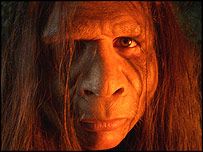The researchers say their findings strongly support an idea that the 1m- (3ft-) tall female skeleton from Indonesia is a diseased modern human.

Their claims have been aired in a BBC Horizon programme screened on Thursday.
The Hobbit's discoverers are adamant it is an entirely separate human species, which evolved a small size in isolation on its remote island home of Flores.
The bones were unearthed during a dig at Liang Bua, a limestone cave deep in the Flores jungle. The discovery caused a sensation when it was announced to the world in 2004.

Analysis of the 18,000-year-old remains showed the Hobbit had reached adulthood, despite her diminutive size.
Long arms, a sloping chin, and other primitive features suggested affinities to ancient human species such as Homo erectus.

And Homo floresiensis, as science properly calls the creature, seems to exhibit other oddities, such as lower premolar teeth with twin roots. In most modern humans, the lower premolars have a single root.
Ancient roots
Australian anthropologists Peter Brown, Mike Morwood, Bert Roberts and others involved in the find, proposed that the Hobbit was a descendent of erectus or some other ancient species that reached Flores just under a million years ago.
Cut off from the rest of the world on this island, the species evolved small stature, much like the pygmy elephants it is thought to have hunted.
Sophisticated stone tools found nearby suggest they were not lacking in intelligence, even though the Hobbit specimen's brain was no larger than a chimpanzee's.
But it was not long before some scientists began to ask serious questions about the discovery team's conclusions.
Indonesian anthropologist Teuku Jacob controversially took possession of the remains and declared them to be those of a modern human with the condition microcephaly.
This disorder is characterised by a small brain, but it can also be associated with dwarfism, as well as abnormalities of the face and jaw. For this reason, some scientists believe the condition could cause a modern human to look primitive in evolutionary terms.
Jacob was soon joined by a handful of researchers in the belief that the discovery team had happened upon nothing more than a member of our own species with a rare disease.
Professor Bob Martin, one of the team that is set to publish new evidence challenging the discovery team's original interpretation, says the Hobbit's brain is "worryingly" small and contradicts a fundamental law of biology.
"What this law says in simple terms is that if you halve body size, brain size is only reduced by 15%," he told the BBC's Horizon programme.
"So if you halve body size you don't halve brain size, the brain is reduced far less than that."
Biological laws
Working under the assumption that the Hobbit was basically a shrunken form of Homo erectus, Professor Martin used this law to find out how big the Hobbit's brain should have been.
Starting with a height of 1.75m and a brain size of 990 cubic centimetres for Homo erectus, Professor Martin used the standard scaling formula to calculate that, given a height of 1m, the Hobbit's brain size should have been about 750 cubic centimetres.
"You can calculate what body height the Hobbit would need to get its brain down to this size, and the answer is... about the size of a meerkat," he said.
However, researchers who carried out the excavation at Liang Bua argue that island isolation can play strange evolutionary tricks.
"If they'd been isolated on this island for 800,000 years by themselves, genetically cut off from the rest of the world, where very few other animals could get to, we'd expect strange things," Mike Morwood of the University of New England, Australia, told Horizon.
But another piece of evidence challenging the discoverers' claims has come from one of the oldest anatomical collections in the world.
More remains
Ann MacLarnon of Roehampton University, UK, has discovered the skull of a microcephalic in the vaults of London's Royal College of Surgeons with a brain that matches that of the Hobbit for size.
"It showed that we really could demonstrate with a specimen that [microcephaly] could explain the Hobbit's small brain," she told Horizon.
But there's a problem with the sceptics' version of the story. The Hobbit team has found more human remains. These include a lower jaw with the same unusual features as the original find (including twin roots to the molars).
"Let's buy into [the sceptics'] argument just for a bit of fun," said Professor Bert Roberts of the University of Wollongong, Australia, a member of the discovery team.
"We've got a complete lower jaw that's identical to the first so there we have a situation where we've now got to have two really badly diseased individuals.
"We've got a diseased population like some sort of leper colony, living in Liang Bua 18,000 years ago. The probabilities have got to be vanishingly small."
The Hobbit team is now looking in other caves on Flores for more evidence of this ancient population.
The sceptics intend to publish their concerns in a scientific journal."




No comments:
Post a Comment